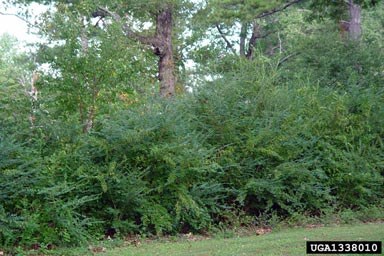Many of the plants we see in our yards are not native to the mid-Atlantic region. Some of these plants are not good neighbors, and refuse to stay in our yards, with disastrous consequences.

Privet eliminates the forest understory. Photo: Nava Tabak, Invasive Plant Atlas of New England, Bugwood.org
Invasive plant species not only threaten our natural areas, they may also invade your garden. Landscape plants that seed freely can cause extra work. Seedlings must be weeded out before they take over and displace plants that were painstakingly planted in your garden. Plants such as bamboo can spread quickly from your garden onto other people's property, decreasing their enjoyment of their property and their enjoyment of having you as a neighbor.
Just because a plant does not seem unmanageable in your garden does not mean that the seeds from your plants are not spreading. The fruits on plants, such as barberry or mile-a-minute, are eaten and spread by birds, causing infestations in faraway places.
Mentioned here is a short list of the plant species causing habitat loss for native plants and animals. Some invasive plants were imported and planted for erosion control or as ornamentals before their detrimental effects were fully realized, some came in as 'hitchhikers' with the movement of people and goods. They can also be spread through hiking and camping activity. Birds and other animals also spread seeds within a region as fruit passes through their digestive systems and seeds cling to feathers or coats.
The major problem with all of the invasive plant species is their lack of any natural controls, have aggressive growth patterns and reproduce rapidly and prolifically. Combined with their lack of nutritional and habitat quality for native wildlife, they are very disruptive in the forest and watershed ecosystems on which we all depend. In our mid-Atlantic region, find out more at:
Plant Invaders of Mid-Atlantic Natural Areas.
National Invasive Species Information Center - Plants
Already in the county:
Butterfly bush (Buddleja davidii)
Japanese stilt grass (Microstegium vimineum) Article, PDF
Mile-a-minute vine (Persicaria perfoliata, formerly Polygonum perfoliatum) Article, PDF
Japanese barberry (Berberis thunbergii) Article, PDF
Japanese spiraea (Spiraea japonica) Article, PDF
Exotic honeysuckle (Lonicera spp.) Article, PDF
Oriental Bittersweet (Celastrus orbiculatus) Article, PDF
Garlic Mustard (Alliaria petiolata) Article, PDF
English Ivy (Hedera helix) Article, PDF
Chinese and Japanese wisteria (Wisteria sinensis and W. floribunda) Article, PDF
On our border:
Wavyleaf basketgrass (Oplismenus hirtellus ssp. undulatifolius) Article, PDF
Worth watching:
Cogongrass (Imperata cylindrica)
For additional information:
i Conserve Pennsylvania Tree Protection and Conservation
Invasive Plants in Pennsylvania
Landscaping with Native Plants
Mid-Atlantic Ecological Landscapes Partnership
Management plans - USDA
For suggestions regarding invasive plant control:
Penn State Pest Management
Weeds Gone Wild - Fact sheets and information on control by species
Penn State Natural Resources Extension - Fact sheets on invasive plant and insect species
For information on other plants to use, visit Native Alternatives
Gypsy Moth
Gypsy moth is a cyclic insect that has been a problem in York county and will be again.
Invasive Tree Pests
Learn about Emerald Ash Borer, Asian Longhorned Beetle, and Thousand Cankers Disease and other tree issues.
Aquatic Invasive Species
Invasive species are not restricted to the land. Many invasive species that are problems in our water bodies are also part of our homes, as pets; in ponds or water gardens; or are moved via our recreational activities.
Native Alternatives
Consider the use of native plants in your yards and gardens instead of non-native plants. Here are resources to assist gardeners in making more eco-friendly selections.
Home and Garden Pests
Here are some unwelcome invasive guests common around the house or in your garden.
http://elibrary.dcnr.pa.gov/GetDocument?docId=1738761&DocName=wisterias.pdf

